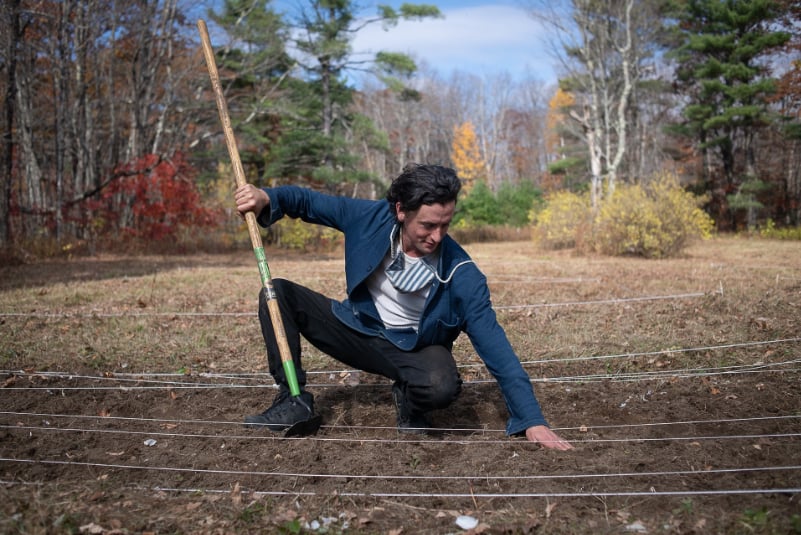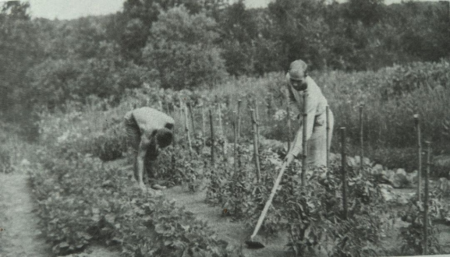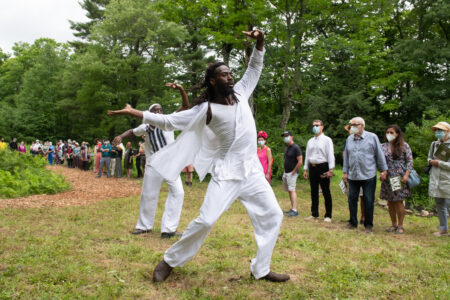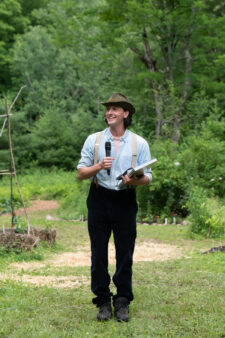A Walk Through Jacob’s Garden

Just around the corner from the main Jacob’s Pillow campus—but within easy walking distance—lies Jacob’s Garden. Jacob’s Pillow inaugurated this special 1.5-acre plot in 2021, through a pilot partnership with Adam H. Weinert and Brett Perry of the Dancing Farmer, LLC. Jacob’s Garden is a place to grow fruits and vegetables and connect to the land’s multiple histories, drawing direct inspiration from Ted Shawn’s original 1931 “friendship garden.”
Although Weinert has focused much recent effort on the establishing of this garden, his accomplished dance career has taken him all over the world. An alumnus of The School at Jacob’s Pillow and now a performance-based artist born and raised in New York City, Weinert has danced with the Metropolitan Opera Ballet Company, the Mark Morris Dance Group, Shen Wei Dance Arts, and Christopher Williams, and has toured performance works to four continents including a number of non-traditional dance venues such as the Museum of Modern Art, Tate Britain, and Tate Modern.

Yet there is something about this certain place that has captivated Weinert, who has spent the last nine years reconstructing the choreographic works of Ted Shawn, the founder of Jacob’s Pillow.
“My goal was to retrace his footsteps as accurately as I could in order to unlock the secrets of the man who helped codify a new art form,” Weinert said in prepared remarks during last summer’s inauguration of Jacob’s Garden. “What I learned was that the dancing was only part of it. Ted Shawn and His Men Dancers tilled their own soil, harvested their crops, raised the barns, and in this way grew the festival and built the repertory. At the core of his vision was a relationship to the land. He wanted his dancers and students in training to be outdoors, live away from the city, and eat a simple and nutritious diet. I think it’s no coincidence that this seed-to-stage approach laid the foundation for what would become the most enduring dance festival this country has ever seen.”
“I get a lot of messages from people who have taken breaks and visited the garden, to say: thank you for creating this space.”
In 2021, Jacob’s Garden began to cultivate staple crops including tomatoes and squash, thanks in large part to 20 visits from the Berkshires-based youth organization Greenagers. This year, focus shifted more to leafy and salad greens, in order to grow and harvest quickly for consumption during the summer months. The bounty has proven to be sizable. In late July, for example, the Pittsfield-based community youth group Roots Rising worked with Weinert and Pillow staff to harvest an impressive 61.5 pounds of heirloom mesclun lettuce, an additional 20 pounds of mixed baby lettuce, and 40 pounds (120 heads) of garlic. Other produce this year includes chives, kale, chard, corn, squash, beans, and arnica flowers to be dried and processed for use in a muscle balm or massage oil for dancers.

Reflecting on the past year and a half, Weinert observes that working with so many young people on the development of the garden has been inspiring and humbling. “In certain ways, they know a lot more about growing food than I do,” he says. “I’ve been in dance for 30 years, but now I’m pivoting into this new arena, where I’m still learning a lot. It was so interesting to work with people who are half my age but who have a deep embodied knowledge, which they’re so generous about sharing. In a lot of ways, you get to know them like you do a dance company.”

This synergy between dance and gardening seems to ring more true the deeper Weinert and Brett Parry delve into this new practice. Parry has recently been conducting interviews with dancers who have become farmers or growers. “It’s been wild to see how many of those people there are,” Weinert says. “It really resonates in a certain way. The list of people we’re going to interview keeps growing and growing. It even includes people I know well, but I didn’t know about this part of their lives!”
When it comes to reactions thus far from audience members, participants and visiting artists, Weinert says that “aside from talk about the food we’re growing, a lot of the feedback is just what a powerfully healing space the garden has become. I get a lot of messages from people who have taken breaks and visited the garden, to say: thank you for creating this space. That tells me that it’s not just about what the garden produces, but the space it creates.”
Garden plans are still evolving for the coming months and years. Weinert and Parry are continuing to develop local community partnerships and find new avenues to donate produce to charity and food pantries. The plan keeps growing, Weinert admits, because when it comes to gardening, “I tend to go in with a plan of maybe three things to do—and then I find another eight things that need to get done!”
Written by Hunter Styles. Published July 2022.